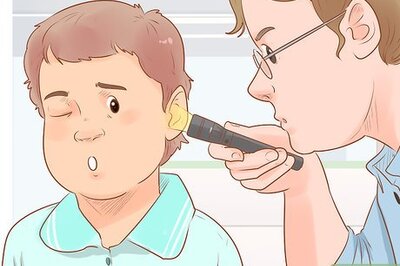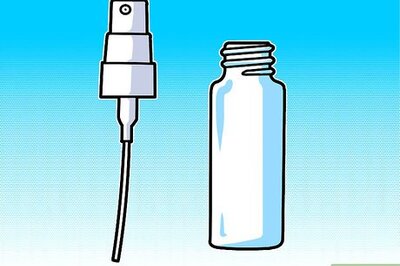
views
Causes of Frigidaire Dishwasher Not Draining
The dishwasher cycle needs to be reset. Sometimes Frigidaire dishwashers undergo a temporary glitch that stops them from draining automatically. If this is the case with your model, a simple override will force the dishwasher to reset and empty out the water.
The dishwasher drain hose is kinked, damaged, or blocked. The drain hose flows dirty water away from the dishwasher to the waste line. Loosening any kinks in the hose will help, but if it's leaking or you find a significant blockage, replacement may be the best option.
The air gap in the drain hose is clogged. The air gap allows air pressure to escape the drain hose, which prevents dirty water from flowing back into the dishwasher. If this gap is clogged with food or other debris, the water may not drain properly from the dishwasher, hence why the bottom is still full at the end of a cycle.
The drain filter in the bottom of the dishwasher is dirty. The filter collects all the large food particles from the dirty dishes during a wash cycle. Over time and without regular cleanings, the filter clogs from all the debris and must be cleaned.
The garbage disposal drain pipe is clogged. If you own a garbage disposal and haven't run it in a long time, food may have collected in the drain pipe underneath it, preventing the dishwasher from draining properly.
The drain check valve isn't opening correctly. The check valve prevents the dirty dishwasher from flowing back in. If it's stuck in a closed position, that can prevent your dishwasher from emptying at the end of a cycle.
The drain pump is worn down or broken. The drain pump is a mechanism that pumps the water out of the bottom of your dishwasher. If it's worn down or broken, it won't do its job and the water will continue to pool.
How to Fix a Frigidaire Dishwasher That's Not Draining
Reset the Frigidaire dishwasher to force it to drain. Most newer Frigidaires have a Start/Cancel button on the display. Press it down for at least 3 seconds to start a manual draining cycle. You can also try unplugging the dishwasher for a few minutes and then plugging it back in to reset it.
Check the drain hose for kinks or holes. Locate the drain hose under the sink and try to straighten out any kinks you find. After that, look for holes or signs of water leaking from the hose. If you find any, replace the hose with one that Frigidaire recommends for your particular model. To replace the drain hose, begin by unplugging the dishwasher, shutting off the water supply valve behind the appliance, and unscrewing the counter mounts with a drill or screwdriver. Then, unscrew and remove the kickplate under the dishwasher and lower the feet by turning them clockwise if they aren't already touching the floor. Arrange towels on the floor to catch any water that drips out of the drain hose, and then slide the dishwasher out from under the cabinet. Lay it on its back or side to gain better access to the bottom. Next, detach the drain hose from the drain pump on the bottom of the dishwasher and the air gap at the other (if you don't have an air gap, the drain hose may be connected to the drainpipe underneath the sink or to the garbage disposal unit). Connect up the new hose and ensure it's free of kinks and that the connections are secure.
Check for blockages in the drain hose by blowing into it. If the air doesn't flow through, there's something blocking it. You can try removing the obstacle with a flat-head screwdriver or a straightened wire hanger, but if that doesn't work or the clog is too deep, the best option is to replace it. Don't use a pipe cleaner to unclog the drain hose! The pipe cleaner has sharp edges and may puncture the hose, and then you'll definitely have to replace it.
Inspect the air gap to see if it's clogged. Remove the stainless steel air gap cover and unscrew the plastic piece underneath. Shine a flashlight into the hole and clean out any debris you see with a stiff brush (like a toothbrush) and tap water. Once it's cleared, replace the air gap and its cover.
Pull out the drain filter or glass trap and clean it free of debris. Remove the bottom rack from your dishwasher and locate the drain filter or glass trap handle. Unscrew it counterclockwise and pull it out. Rinse it in warm water to remove any food debris, let it dry, and put it back in the dishwasher. To remove food and grime that won't rinse off, soak the filter or glass trap in warm, soapy water for 10 minutes. You can also use a soft brush to scrub off particularly stubborn debris. Rinse the soap off and let it dry before reinstalling it. Cleaning expert Chris Willatt recommends cleaning your drain filter once a month and your whole dishwasher every six months. To eliminate hard mineral deposit buildup (which can also contribute to clogging), Willatt says to fill the dishwasher with ⁄4 in (0.64 cm) of vinegar and run a full cycle with it. The acidity in the vinegar will dissolve the minerals.
Run the garbage disposal to clear any blockages. When you turn the garbage disposal on, run it for 15 seconds after you hear it stop grinding to help break up and remove any remaining food buildup.
Inspect the check valve to ensure it's not stuck closed. The check valve is located on the bottom of your Frigidaire dishwasher, just insid ethe drain tube. To access it, unplug the dishwasher, slide it out from under the counter, and set it on its back. Then, disconnect the drain hose from the drain tube and evaluate the condition of the rubber check valve flap. If it's stuck or the tube is blocked with debris, clear it to fix the issue.
Inspect the drain pump for signs of wear and tear. The drain pump is located on the bottom of the dishwasher, so you'll need to unplug it, turn off the water supply, and unscrew and remove the kickplate to access it. Disconnect the wires from the drain pump and use a nut driver to loosen the hose clamp, so you can remove the drain hose from the pump. Then lower the support feet (if necessary), pull the dishwasher out from under the counter, and lay the dishwasher on its side or back. Locate the drain pump on the bottom of the dishwasher. Use a set of channel locks to grip the drain pump hose clamp and move it to one side. Next, use a thin tool like pliers or a screwdriver to leverage the plastic tabs holding the pump in place, so you can pop the pump off. If the pump appears cracked, brittle, or broken, replace it with a brand-new one that matches Frigidaire's recommendation for your model. Align it and push it into place, and then use your channel locks to squeeze the clamps back into place. Reattach the drain hose, screw the hose clamp back on, and put your dishwasher back into place. Turn the water valve back on, plug the dishwasher in, and run a cycle to see if a bad pump was the source of the drainage problem.



















Comments
0 comment